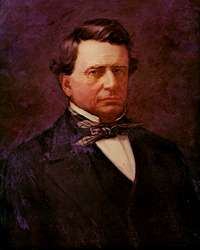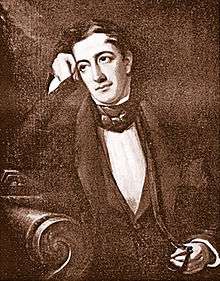United States House of Representatives elections, 1844
| | |||||||||||||||||||||||||||||||||||||||||||
| |||||||||||||||||||||||||||||||||||||||||||
| |||||||||||||||||||||||||||||||||||||||||||
| |||||||||||||||||||||||||||||||||||||||||||
Elections to the United States House of Representatives for the 29th Congress were held at different dates in the various states from July 1, 1844 (Louisiana) to November 4, 1845 (Mississippi). All 227 members of the House of Representatives elected[Note 3] took their seats when Congress convened December 1, 1845. The elections mostly coincided with the 1844 presidential election, won by dark horse Democratic candidate James K. Polk, who won on a campaign advocating territorial expansion. The new states of Florida, Texas and Iowa were added during this Congress. Florida had actually been admitted on the last day of the 28th Congress, but was not represented until the 29th. Iowa and Texas both elected their first representatives in 1846.
Despite Polk's victory, the Democrats had a net loss of six Representatives. They still retained a large majority of 142-79 over their major rivals, the Whigs. The American Party, based on the nativist "Know Nothing" movement characterized by opposition to immigration and anti-Catholicism, gained six seats, its first in Congress. The fragmentation of votes by this new party, combined with a generally negative political environment cause by dislike of outgoing President John Tyler, contributed to the slight Democratic loses.
Election summaries
Five seats were added for the new States of Florida[1] (1), Iowa[2] (2), and Texas[3] (2). Florida was represented for the entirety of the 29th Congress, while Texas was unrepresented for part of the 1st session and Iowa for all of the 1st session.
| 142 | 6 | 79 |
| Democratic | AKN | Whig |
| State | Type | Date | Total seats |
Democratic | Whig | Know Nothing | |||
|---|---|---|---|---|---|---|---|---|---|
| Seats | Change | Seats | Change | Seats | Change | ||||
| Arkansas | At-large | October 8, 1844 | 1 | 1 | 0 | 0 | |||
| Delaware | At-large | November 12, 1844 | 1 | 0 | 1 | 0 | |||
| Georgia | District[Note 4] | August 7, 1844 | 8 | 4 | 4 | 0 | |||
| Illinois | District | August 5, 1844 | 7 | 6 | 1 | 0 | |||
| Louisiana | District | July 1–3, 1844 | 4 | 3 | 1 | 0 | |||
| Maine | District | September 9, 1844 | 7 | 6 | 1 | 0 | |||
| Massachusetts | District | November 11, 1844 | 10 | 0 | 10 | 0 | |||
| Michigan | District | November 5, 1844 | 3 | 3 | 0 | 0 | |||
| Missouri | At-large | August 5, 1844 | 5 | 5 | 0 | 0 | |||
| New Jersey | District | October 9, 1844 | 5 | 1 | 4 | 0 | |||
| New York | District | November 11, 1844 | 34 | 21 | 9 | 4 | |||
| Ohio | District | October 8, 1844 | 21 | 13 | 8 | 0 | |||
| Pennsylvania | District | October 8, 1844 | 24 | 12 | 10 | 2 | |||
| South Carolina | District | October 14–15, 1844 | 7 | 7 | 0 | 0 | |||
| Vermont | District | September 3, 1844 | 4 | 1 | 3 | 0 | |||
| 1845 elections | |||||||||
| Alabama | District | August 4, 1845 | 7 | 6 | 1 | 0 | |||
| Connecticut | District | April 7, 1845 | 4 | 0 | 4 | 0 | |||
| Florida[Note 5] | At-large | May 26, 1845 | 1 | 1 | 0 | 0 | |||
| Indiana | District | August 4, 1845 | 10 | 8 | 2 | 0 | |||
| Kentucky | District | August 4, 1845 | 10 | 3 | 7 | 0 | |||
| Maryland | District | October 1, 1845 | 6 | 4 | 2 | 0 | |||
| Mississippi | At-large | November 3–4, 1845 | 4 | 4 | 0 | 0 | |||
| New Hampshire | At-large | March 11, 1845 | 4[Note 3] | 3 | 0 | 0 | |||
| North Carolina | District | August 7, 1845 | 9 | 6 | 3 | 0 | |||
| Rhode Island | District | April 2, 1845 | 2 | 0 | 2 | 0 | |||
| Tennessee | District | August 7, 1845 | 11 | 6 | 5 | 0 | |||
| Virginia | District | April 24, 1845 | 15 | 14 | 1 | 0 | |||
| 1846 elections | |||||||||
| Iowa[Note 5] | At-large | October 26, 1846 | 2 | 2 | 0 | 0 | |||
| Texas[Note 5] | District | March 30, 1846 | 2 | 2 | 0 | 0 | |||
| Total | 227[Note 2][Note 3] | 142 62.6% |
|
79 34.8% |
|
6 2.6% |
| ||
Complete returns
Florida
| District | Incumbent | Party | First elected |
Result | Candidates |
|---|---|---|---|---|---|
| Florida at-large | None (New state) | Democratic gain | David Levy Yulee (D) 60.3 Benjamin A. Putnam (W) 39.7% | ||
Yulee did not serve, being elected to the Senate. A special election was held which was, initially, won by Edward C. Cabell (W). The election was successfully challenged by William H. Brockenbrough (D).
See also
Notes
- ↑ Excludes states admitted during the 29th Congress
- 1 2 3 Includes late elections
- 1 2 3 4 There was a single vacancy in New Hampshire's representation, which went unfilled for the duration of the 29th Congress – see: Dubin, p. 142-143; Martis, p. 98-99.
- ↑ Changed from at-large
- 1 2 3 New State
- ↑ Previous election had 2 members of the short-lived Law and Order Party
References
Bibliography
- Dubin, Michael J. (March 1, 1998). United States Congressional Elections, 1788-1997: The Official Results of the Elections of the 1st Through 105th Congresses. McFarland and Company. ISBN 978-0786402830.
- Martis, Kenneth C. (January 1, 1989). The Historical Atlas of Political Parties in the United States Congress, 1789-1989. Macmillan Publishing Company. ISBN 978-0029201701.
- Moore, John L., ed. (1994). Congressional Quarterly's Guide to U.S. Elections (Third ed.). Congressional Quarterly Inc. ISBN 978-0871879967.
- "Party Divisions of the House of Representatives* 1789–Present". Office of the Historian, House of United States House of Representatives. Retrieved January 21, 2015.
External links
- Office of the Historian (Office of Art & Archives, Office of the Clerk, U.S. House of Representatives)


